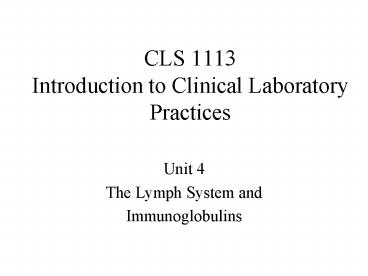CLS 1113 Introduction to Clinical Laboratory Practices - PowerPoint PPT Presentation
1 / 20
Title:
CLS 1113 Introduction to Clinical Laboratory Practices
Description:
Lymphocytes are wholly responsible for the specific immune ... Flat bilobed organ in the chest cavity. Increases in size until puberty and then atrophies. ... – PowerPoint PPT presentation
Number of Views:53
Avg rating:3.0/5.0
Title: CLS 1113 Introduction to Clinical Laboratory Practices
1
CLS 1113Introduction to Clinical Laboratory
Practices
- Unit 4
- The Lymph System and
- Immunoglobulins
2
The Lymph System
- Lymphocytes are wholly responsible for the
specific immune recognition of pathogens, thus
initiating acquired immunity. - Lymphocytes make up 20-40 of circulating WBCs.
- Lymphocytes are derived from bone marrow stem
cells - T cells develop in the thymus
- B Cells develop in the bone marrow
3
Primary Lymph Organs
- Bone Marrow
- Main source of hematopoietic cells - antigen
independent lymphopoiesis - Largest tissue in the body
- B lymphocytes differentiate
- Thymus
- Flat bilobed organ in the chest cavity.
- Increases in size until puberty and then
atrophies. - T lymphocytes differentiate
4
Secondary Lymph Organs
- The secondary lymph organs include
- Spleen, lymph nodes, tonsils, and the appendix
- Upon differentiation the T and B cells migrate to
secondary lymph organs Recirculate - Approx 1-2 total Lymph / hour
- Because lymphocytes are very specific for certain
antigens, they must circulate to increase the
chances of detection. - Antigen dependent lymphopoiesis
5
Secondary Lymph Organs
- Spleen
- Red Pulp Culling of senescent red blood cells
- White Pulp Lymphoid tissue filter
- Primary Follicle unstimulated B Cells
- Lymph Nodes
- Serve as central collecting points for lymph
fluid from tissues - Filtration Phagocytosis, antigen processing and
generation of B Cell memory - Secondary Follicle Antigen stimulated
proliferating - B cells
6
Secondary Lymph Organs
- Tonsils
- Respond to respiratory and alimentary tract
pathogens - Potential site for Antigen contact
- Appendix
- Potential site for Antigen contact
7
Surface Markers on Lymphs
- Lymphocytes express many molecules (proteins)
called Markers on the cell surface which are
used to differentiate cell populations, etc.,
i.e. B and T cells - Systematic Nomenclature CD (Cluster of
Differentiation) - Groups or Clusters of Monoclonal antibodies that
bind to a specific marker.
8
CD Markers
- CD4 is the Marker expressed on T helper cells.
T helper cells are very active in our cell
mediated immunity. - The HIV virus attaches to the CD4 markers on T
cells - (route of entry) that is why HIV patients
progressively lose their immune function. - CD8 cells are T suppressor cells / cytotoxic T
cells. CD8 cells help keep our immune system
under control and help fight tumors (cytotoxic). - The CD markers on our white cells change as the
cell matures helping us define maturity or age of
the cells.
9
Antibody Structure and Function Immunoglobulins
- When B cells are stimulated by antigen they
undergo differentiation and produce Antibodies
a.k.a. Immunoglobulins (Ig) - Glycoproteins found in the serum
- Five classes with names based on electrophoretic
pattern IgG, IgM, IgA, IgD and IgE - These differ in size, charge, amino acid
concentration and carbohydrate content. - Humoral Immunity
10
Immunoglobulin Structure
- All Igs are made up of a four chain polypeptide
unit - Two large chains HEAVY (H) Chains
- Two small chains LIGHT (L) Chains
- Two types ? (kappa) and ? (lambda)
- FAB Fragment Antigen Binding
- Portion of the antibody that binds to the antigen
- Fc Fragment crystalline
- Portion of the antibody that remains constant
11
(No Transcript)
12
(No Transcript)
13
IgG
- 75 of Serum Immunoglobulins
- Monomer 2 Heavy Chains 2 Light Chains
- Cross Placental Barrier
- Number of Sub-Classes
- Complement Activation
- Optimum Temperature
- Predominant Ig in SECONDARY immune response
- Table 5-1
14
(No Transcript)
15
(No Transcript)
16
IgM
- 10 of total serum Immunoglobulin
- Pentamer
- 10 Heavy 10 Light Chains
- Includes also a J (joining) chain
- Predominant Ig in Primary immune response
- Complement activation
- Optimum Temperature
- Cross Placental Barrier
- Presence on Lymphocyte membrane
17
(No Transcript)
18
Immunoglobulins
- IgA
- Location- body secretions
- Dimer
- Contains a secretory component
- J Chain
- IgE
- Low plasma concentration
- Bound to basophils and mast cells
- Triggers release of histamines
19
Immunoglobulins
- IgD
- Complete function unknown
- It is speculated that IgDs play a role in keep
in the immune system under control (suppression).
20
(No Transcript)































